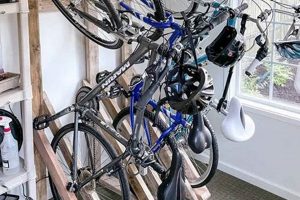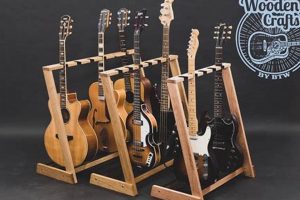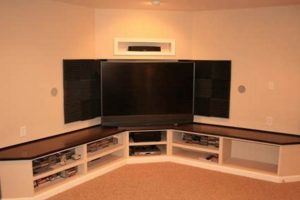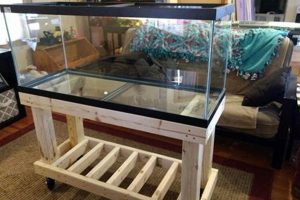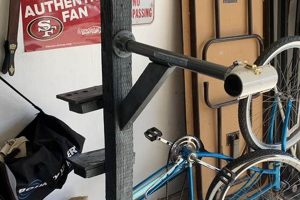A custom-built support for a microphone, often constructed from readily available materials, provides an alternative to commercially manufactured microphone stands. These fabricated supports offer a solution for audio recording or amplification when conventional equipment is unavailable or cost-prohibitive. For instance, a repurposed camera tripod or a collection of metal pipes can be adapted to hold a microphone securely.
The construction of such a support structure can provide significant cost savings and customization options. Historically, resourceful individuals in music and audio production have utilized makeshift solutions to address immediate needs. This approach allows for tailoring the height, angle, and stability of the microphone to specific recording environments or performance settings. Benefits include the potential for unique designs and adaptations to unconventional spaces.
The subsequent sections will explore the different materials commonly employed in these projects, detailing step-by-step construction methods and offering advice on ensuring stability and functionality. Further discussion will address safety considerations and potential troubleshooting scenarios that may arise during the building process.
Essential Considerations for Custom Microphone Supports
Constructing a microphone support necessitates careful planning and execution. The following tips address critical aspects of design, stability, and safety.
Tip 1: Material Selection. Choose materials based on availability, cost, and structural integrity. Metal pipes, wooden dowels, and durable plastics are viable options. Ensure selected materials can withstand the weight of the microphone and any associated accessories.
Tip 2: Stability Assessment. A stable base is paramount. Broad bases or weighted foundations prevent tipping. Consider using sandbags or metal weights to enhance stability, particularly when using lighter materials for the stand’s structure.
Tip 3: Adjustable Height Mechanisms. Incorporating a mechanism for height adjustment increases versatility. Telescoping tubes with locking mechanisms or threaded rods allow for precise microphone positioning.
Tip 4: Secure Microphone Mounting. The microphone must be securely attached to the stand. Standard microphone clips or custom-built holders provide a reliable connection point. Ensure compatibility between the microphone’s thread size and the mounting hardware.
Tip 5: Vibration Dampening. Isolate the microphone from vibrations to minimize unwanted noise. Rubber feet or foam padding at contact points reduce the transmission of vibrations from the floor or stand structure.
Tip 6: Cable Management. Plan for cable routing to prevent tangling and potential tripping hazards. Cable clips or ties attached to the stand keep cables organized and out of the way.
Tip 7: Safety Precautions. Exercise caution when working with tools and materials. Wear appropriate safety gear, such as eye protection and gloves. Secure all connections to prevent accidental detachment of the microphone.
By adhering to these guidelines, one can create a functional and reliable microphone support that meets specific recording or performance needs.
The subsequent sections will delve into specific construction projects, providing detailed instructions and visual aids to guide the building process.
1. Material strength
The integrity of a custom microphone support hinges directly on the strength of the materials used in its construction. Insufficient material strength compromises the structure’s ability to bear the weight of the microphone and related accessories, potentially leading to instability or collapse. For instance, employing thin-walled PVC piping for a tall stand designed to hold a heavy condenser microphone could result in bending or fracture, rendering the support unusable and posing a risk to the equipment.
The selection of appropriate materials is therefore paramount. Metal pipes, such as steel or aluminum, offer superior load-bearing capacity compared to plastics. Wood, while aesthetically pleasing, requires careful selection of species and dimensions to ensure adequate strength. Understanding the tensile and compressive strength of various materials allows builders to make informed decisions, balancing cost considerations with structural requirements. Real-world applications often see the use of heavy-gauge steel for the base and vertical support, combined with lighter, more easily adjustable materials for the microphone mount itself.
In summation, material strength represents a critical factor in the design and fabrication of microphone supports. Ignoring this aspect can lead to structural failure and equipment damage. A thorough assessment of the microphone’s weight and the intended use of the stand should guide the selection of materials, ensuring a stable and reliable recording or performance setup.
2. Base stability
Base stability constitutes a fundamental requirement for any self-constructed microphone support structure. The absence of a stable base precipitates a high risk of tipping, potentially damaging the microphone itself and disrupting recording or performance activities. The correlation between a robust base and the overall utility of a fabricated microphone stand is direct and significant. For example, a circular base with a small diameter is inherently less stable than a tripod base with a wider footprint. The former is susceptible to toppling even with minor disturbances, whereas the latter offers greater resistance to external forces.
Weight distribution also critically impacts stability. A heavy microphone positioned at the end of a long boom arm generates a substantial torque force on the base. To counteract this force, the base must possess sufficient weight and a wide enough stance to maintain equilibrium. Failure to account for torque can lead to instability even with an otherwise adequate base design. Practical applications often involve adding weights to the base, such as sandbags or metal plates, to augment its stability and counteract the destabilizing effects of microphone placement.
In conclusion, base stability represents a non-negotiable aspect of a custom microphone support. Ignoring this element compromises the functionality and safety of the entire structure. Therefore, careful consideration of base design, weight distribution, and the anticipated operating environment is essential to ensure a reliable and stable microphone support system. The structural success heavily relies on base stability.
3. Height adjustability
Height adjustability is a crucial design element in the construction of a custom microphone stand, dictating its adaptability to diverse recording or performance scenarios. A fixed-height support limits usability, whereas an adjustable design permits optimal microphone placement relative to the sound source. This adaptability directly impacts the quality of the recorded audio and the comfort of the performer. Consider, for example, a vocalist who prefers to stand during recording versus one who prefers to sit. A stand with fixed height necessitates compromise, potentially affecting vocal performance. An adjustable stand allows both vocalists to position the microphone optimally.
The implementation of height adjustability in a fabricated support often involves telescoping mechanisms or threaded rods. Telescoping designs typically utilize two or more concentric tubes that slide within each other, secured by locking collars or clamps. This approach allows for rapid and incremental height adjustments. Threaded rods, conversely, offer finer height control but may require more time to adjust. The selection of a specific adjustment mechanism depends on the intended use case and the desired level of precision. A drum set microphone stand, for instance, may benefit from a quick-release telescoping design to facilitate rapid repositioning during performance.
In summary, height adjustability significantly enhances the functionality and versatility of a self-made microphone stand. This attribute allows the user to tailor the microphone placement to specific recording or performance conditions, optimizing audio capture and performer comfort. The choice of adjustment mechanism should align with the intended application, balancing speed, precision, and ease of use. The height adjustability is an import element in diy mic stand.
4. Mic attachment
The secure attachment of a microphone to a custom-built support structure is paramount for ensuring both the safety of the equipment and the quality of the audio capture. The absence of a reliable attachment mechanism directly compromises the functionality of the support. A microphone that is inadequately secured is susceptible to slippage, causing unwanted noise from physical movement or, in more severe cases, resulting in the microphone falling and sustaining damage. The connection, therefore, serves as a critical juncture between the microphone and its support.
Various attachment methods exist, ranging from standard microphone clips to custom-fabricated holders. The choice of method should align with the specific microphone model and the intended application of the support. Standard clips, available in a variety of sizes and materials, offer a convenient and cost-effective solution for many microphones. However, for microphones with unconventional shapes or sizes, a custom-designed holder may be necessary to ensure a secure and stable fit. An example of the importance of secure attachment is when recording drums, where vibrations and movement are prominent. A standard clip might not be sufficient, necessitating a more robust and custom-fitted solution to prevent the microphone from detaching.
In conclusion, the method of microphone attachment represents a vital consideration in the design and construction of a custom microphone support. A secure and reliable connection protects the microphone from damage and ensures consistent audio capture. Careful selection of the appropriate attachment method, tailored to the specific microphone and application, is essential for creating a functional and durable support structure.
5. Vibration damping
Vibration damping is a critical, often overlooked, aspect of homemade microphone stands. Extraneous vibrations transmitted through the stand can degrade audio quality, introducing unwanted noise that complicates recording and mixing processes. Effective damping minimizes these disturbances, ensuring a cleaner, more professional sound.
- Material Selection for Vibration Isolation
The choice of materials significantly influences vibration transmission. Dense, rigid materials like metal tend to transmit vibrations readily, whereas softer, more pliable materials like rubber or specialized foams absorb and dissipate vibrational energy. Integrating these damping materials at key contact points within the structure of the stand such as the base, joints, and microphone mount reduces the transmission of unwanted resonance.
- Damping Mechanisms in Stand Design
Implementing design features that inherently dampen vibrations is essential. For example, using a multi-layered base with alternating layers of dense and damping materials can effectively isolate the microphone from floor vibrations. Similarly, employing flexible couplings or shock mounts at the microphone attachment point minimizes the transfer of vibrations from the stand itself to the microphone capsule. Suspending the microphone using elastic cords is another effective technique.
- Practical Applications and Modifications
Real-world applications of damping techniques in microphone support construction involve strategic placement of damping materials. Adding rubber feet to the base of the stand isolates it from the floor. Wrapping joints with damping tape reduces vibrations transmitted through the stand’s frame. Installing a commercially available shock mount between the microphone and the stand further minimizes vibration transfer. These modifications, though often simple, yield considerable improvements in audio quality.
- Troubleshooting and Optimization
Identifying and addressing vibration-related issues often requires careful listening and experimentation. If recordings exhibit low-frequency rumble or extraneous noise, systematically isolating potential sources of vibration is necessary. This may involve testing different damping materials, adjusting the tension of elastic suspension systems, or repositioning the stand to minimize contact with vibrating surfaces. Fine-tuning the damping characteristics of the stand optimizes its performance in a specific recording environment.
The effectiveness of a custom microphone stand hinges not only on its structural integrity and stability but also on its ability to minimize the transmission of unwanted vibrations. By incorporating strategic damping techniques, the audio quality of recordings or live performances can be significantly improved, resulting in a cleaner and more professional sound. Addressing vibration damping is an essential part of crafting a diy mic stand.
6. Cable Management
Effective cable management is intrinsically linked to the design and functionality of any custom-built microphone support. Disorganized cabling not only presents an unprofessional appearance but also poses potential hazards, hindering mobility and increasing the risk of equipment damage or accidental disconnections. Therefore, a well-considered cable management strategy is an essential component of a comprehensively designed microphone support.
- Safety and Hazard Prevention
Unmanaged cables create tripping hazards and increase the likelihood of accidental disconnections, potentially interrupting recording sessions or live performances. Integrating cable routing solutions into the stand’s design, such as clips or channels, mitigates these risks by keeping cables secured and out of the way. This proactive approach enhances safety and reduces the potential for disruptions.
- Aesthetic Considerations and Professionalism
Neatly organized cables contribute to a more professional aesthetic, both on stage and in recording environments. Clear cable runs present a cleaner, more organized appearance, enhancing the overall impression of competence and attention to detail. Conversely, a tangled mess of cables detracts from the presentation and can be perceived as unprofessional.
- Signal Integrity and Noise Reduction
Proper cable management minimizes cable stress and prevents tangling, reducing the risk of damage to the cables themselves. Damaged cables can introduce noise and signal degradation, compromising the audio quality. By securing cables to the stand, the potential for kinking, stretching, or other forms of physical stress is minimized, preserving signal integrity.
- Portability and Setup Efficiency
A well-designed cable management system facilitates quicker and more efficient setup and teardown. When cables are pre-routed and secured to the stand, the entire assembly can be moved and positioned as a single unit, reducing the time and effort required for each setup. This is particularly advantageous in situations where the stand needs to be frequently moved or transported.
The integration of effective cable management solutions represents a critical aspect of constructing a functional and professional microphone support. Addressing cable routing, security, and organization enhances safety, improves aesthetics, preserves signal integrity, and streamlines setup processes. A carefully considered cable management strategy elevates the overall utility and reliability of any self-made microphone stand.
7. Portability
Portability constitutes a significant design consideration for any custom-built microphone support, influencing its suitability for various recording and performance environments. The ease with which a stand can be transported and assembled directly impacts its utility, particularly for musicians, sound engineers, or presenters who require a mobile setup. Therefore, an analysis of portability considerations is essential.
- Collapsible Design and Compact Storage
A microphone stand designed for portability often incorporates collapsible components or a modular structure, enabling it to be disassembled and stored in a compact form. This design facilitates ease of transport in a vehicle or storage in a limited space. Examples include stands with folding legs, telescoping sections that retract, or detachable base components. These features allow the stand to occupy a minimal footprint during transport.
- Lightweight Material Selection
The weight of the materials used in construction directly affects the stand’s portability. Substituting heavier materials, such as steel, with lighter alternatives like aluminum or durable plastics reduces the overall weight, making the stand easier to carry. Trade-offs between weight and stability must be carefully considered to ensure that the reduced weight does not compromise the stand’s ability to support the microphone securely.
- Integrated Carrying Solutions
Incorporating integrated carrying solutions, such as handles, straps, or custom-fitted cases, enhances the portability of a microphone stand. These features facilitate convenient carrying and protect the stand from damage during transport. A handle attached to the stand’s base or a dedicated carrying bag with shoulder straps allows for hands-free transport, freeing the user to carry other essential equipment.
- Assembly and Disassembly Efficiency
A portable microphone stand should be designed for quick and easy assembly and disassembly, enabling the user to set up and pack down the stand efficiently. Complex assembly processes can negate the benefits of portability, particularly in situations where time is limited. Therefore, the design should prioritize intuitive connections and minimal tools required for assembly.
These elements underscore the importance of factoring portability into the design and construction of a homemade microphone stand. The ability to easily transport and set up a microphone support significantly broadens its applicability, making it suitable for a wide range of recording and performance scenarios. The focus on Portability often decides diy mic stand is successful or not.
Frequently Asked Questions
The following questions address common inquiries regarding the design, construction, and utilization of self-made microphone stands, offering clarity on key aspects and potential challenges.
Question 1: What are the primary advantages of constructing a microphone stand as opposed to purchasing a commercially manufactured model?
Construction allows for customization tailored to specific recording environments or performance needs, often at a reduced cost. The ability to utilize readily available materials contributes to resourcefulness and potential cost savings.
Question 2: What constitutes the most critical factor in ensuring the stability of a self-constructed microphone support?
The stability of the base is paramount. A wide footprint or weighted base prevents tipping, particularly when supporting heavier microphones or boom arms.
Question 3: How can one effectively minimize unwanted vibrations transmitted through a microphone stand?
Employing vibration damping techniques, such as incorporating rubber feet, foam padding, or a shock mount, reduces the transmission of vibrations to the microphone capsule.
Question 4: What safety precautions should be observed when constructing a custom microphone support?
Exercising caution when working with tools and materials, wearing appropriate safety gear, and ensuring secure connections are crucial for preventing accidents and injuries.
Question 5: How does height adjustability enhance the functionality of a microphone stand?
Height adjustability permits precise microphone positioning, accommodating various recording scenarios and performer preferences, optimizing audio capture.
Question 6: What are the key considerations for ensuring secure microphone attachment to the support structure?
Selecting an attachment method appropriate for the microphone’s shape and weight, ensuring compatibility between the microphone’s thread size and the mounting hardware, and securing all connections prevents slippage or detachment.
These FAQs offer concise guidance on the essential aspects of crafting functional and reliable microphone stands. They underscore the need for careful planning, meticulous execution, and a comprehensive understanding of the principles of structural stability and audio quality.
The subsequent sections will delve into specific construction projects, providing detailed instructions and visual aids to guide the building process.
Conclusion
This exploration of “diy mic stand” construction has underscored the importance of several core principles: material strength, base stability, height adjustability, microphone attachment, vibration damping, cable management, and portability. The careful consideration of these elements dictates the ultimate functionality and reliability of the support. Each aspect contributes to the overall goal of providing a stable, adaptable, and acoustically sound platform for microphone use. The potential for cost savings and customization makes this approach an attractive alternative to commercially produced options.
While resourcefulness and ingenuity are valuable assets, adherence to safety protocols and a thorough understanding of structural integrity are paramount. Careful planning and execution remain crucial for avoiding potential hazards and ensuring the longevity of the constructed support. Future advancements in materials science and design methodologies may further enhance the practicality and sophistication of self-constructed microphone stands, broadening their appeal within the audio production and performance communities. Continued refinement of techniques within the diy mic stand process can lead to improved, robust, and cost-effective solutions for audio professionals and enthusiasts alike.


